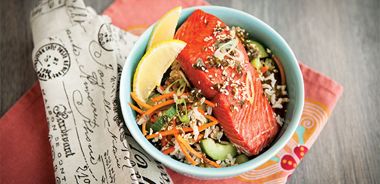Nori Salmon with Seaweed Rice Salad

A double shot of seaweed—nori and wakame—lends this dish a salty flavour without an excess of sodium. The nori garnish is a version of furikake, a Japanese condiment typically sprinkled over rice. If desired, rainbow trout or Arctic char can be used in lieu of salmon.
1 cup (250 mL) brown rice
1 lb (450 g) wild salmon, cut into 4 equal-sized pieces
2 nori sheets
1/4 cup (60 mL) sesame seeds
1 tsp (5 mL) sesame oil
1/2 oz (14 g) dried wakame seaweed
1 English cucumber
2 medium carrots
2 green onions, white and green parts only, thinly sliced
Juice of 1/2 lemon
Place rice and 2 cups (500 mL) water in medium-sized saucepan. Bring to a boil, reduce heat, cover, and simmer until tender, about 25 minutes. Drain excess water.
Preheat oven to 400 F (200 C). Place salmon on parchment paper-lined baking sheet and bake until just cooked through, about 12 minutes.
Using kitchen shears, cut nori into small pieces and combine with sesame seeds. Heat skillet over medium heat and toast nori mixture for 3 to 4 minutes, or until fragrant and sesame seeds have browned. Stir in sesame oil.
Place wakame in large bowl, cover with water, and let rehydrate for 10 minutes. Drain, squeeze out excess moisture, and chop into small pieces. Slice cucumber in half lengthwise, scrape out seeds, and thinly slice horizontally. Slice carrots into thin matchsticks.
Toss together rice, wakame, cucumber, carrots, and green onions. Divide rice mixture among serving plates and top with salmon. Squeeze lemon juice over salmon and garnish with nori mixture.
Serves 4.
Each serving contains: 346 calories; 33 g protein; 15 g total fat (2 g sat. fat, 0 g trans fat); 20 g total carbohydrates (3 g sugars, 4 g fibre); 124 mg sodium
source: "5 Flavour Surprises", alive #380, June 2014





